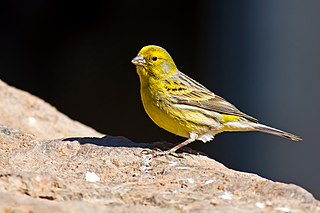 W
WThis is a list of the bird species recorded in Madeira. The avifauna of Madeira include a total of 353 species, of which two are endemic, and 9 have been introduced by humans. The two listed species that are extinct. 14 species are globally threatened.
 W
WThe band-rumped storm petrel, Madeiran storm petrel, or Harcourt's storm petrel is of the storm petrel family Hydrobatidae.
 W
WThe Atlantic canary, known worldwide simply as the wild canary and also called the island canary, common canary, or canary, is a small passerine bird belonging to the genus Serinus in the finch family, Fringillidae. It is native to the Canary Islands, the Azores, and Madeira. Wild birds are mostly yellow-green, with brownish streaking on the back. The species is common in captivity and a number of colour varieties have been bred.
 W
WThe Madeira firecrest, Madeira kinglet, or Madeiracrest is a very small passerine bird endemic to the island of Madeira. It is a member of the kinglet family. Before it was recognised as a separate species in 2003, it was classified as a subspecies of the common firecrest. It differs in appearance and vocalisations from its relative, and genetic analysis has confirmed it as a different species. The Madeiran bird has green upperparts, whitish underparts and two white wingbars, and a distinctive head pattern with a black eye stripe, short white supercilium, and a crest that is mainly orange in the male and yellow in the female.
 W
WThe Madeiran chaffinch is a small passerine bird in the finch family Fringillidae. It is a subspecies of the common chaffinch that is endemic to the Portuguese island of Madeira, part of Macaronesia in the North Atlantic Ocean. It is locally known as the tentilhão.
 W
WThe Madeiran scops owl is a small extinct owl that once inhabited the island of Madeira in the Macaronesian archipelago off the north-west coast of Africa in the North Atlantic Ocean.
 W
WZino's petrel or freira, is a small seabird in the gadfly petrel genus which is endemic to the island of Madeira. This long-winged petrel has a grey back and wings, with a dark "W" marking across the wings, and a grey upper tail. The undersides of the wings are blackish apart from a triangle of white at the front edge near the body, and the belly is white with grey flanks. It is very similar in appearance to the slightly larger Fea's petrel, and separating these two Macaronesian species at sea is very challenging. Zino's was formerly considered to be a subspecies of the soft-plumaged petrel, P. mollis, but they are not closely related, and Zino's was raised to species status because of differences in morphology, calls, breeding behaviour and mitochondrial DNA. It is Europe's most endangered seabird, with breeding areas restricted to a few ledges high in the central mountains of Madeira.
 W
WBerthelot's pipit is a small passerine bird which breeds in Madeira and the Canary Islands. It is a common resident in both archipelagos.
 W
WThe plain swift is a medium-sized swift. Although this bird is superficially similar to a barn swallow or house martin, it is not related to those passerine species. The resemblances between the groups are due to convergent evolution reflecting similar life styles.
 W
WCory's shearwater is a large shearwater in the seabird family Procellariidae. The genus name Calonectris comes from Ancient Greek kalos, "good" and nectris, "swimmer", and borealis is Latin for "northern". The English name is after the American ornithologist Charles B. Cory.
 W
WThe trocaz pigeon, Madeira laurel pigeon or long-toed pigeon is a pigeon which is endemic to the island of Madeira. It is a mainly grey bird with a pinkish breast; its silvery neck patch and lack of white wing markings distinguish it from its close relative and probable ancestor, the common wood pigeon. Its call is a characteristic six-note cooing, weaker and lower-pitched than that of the wood pigeon. Despite its bulky, long-tailed appearance, this pigeon has a fast, direct flight.
 W
WThe grey wagtail is a member of the wagtail family, Motacillidae, measuring around 18–19 cm overall length. The species looks somewhat similar to the yellow wagtail but has the yellow on its underside restricted to the throat and vent. Breeding males have a black throat. The species is widely distributed, with several populations breeding in Eurosiberia and migrating to tropical regions in Asia and Africa. The species is always associated with running water when breeding, although they may use man-made structures near streams for the nest. Outside the breeding season, they may also be seen around lakes, coasts and other watery habitats. Like other wagtails, they frequently wag their tail and fly low with undulations and they have a sharp call that is often given in flight.